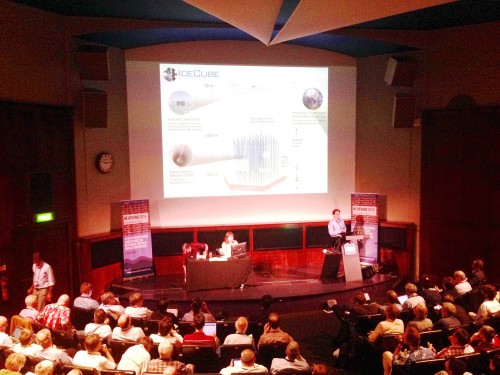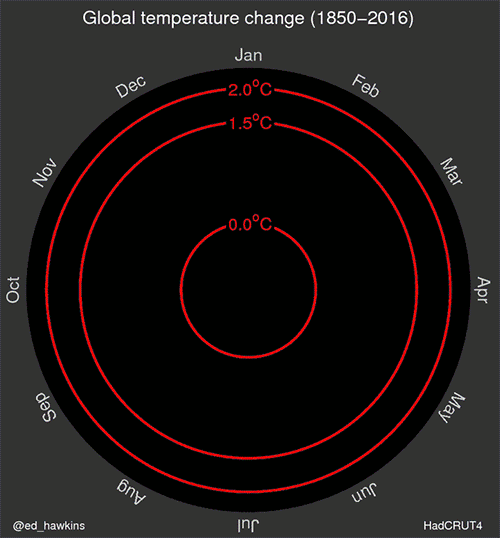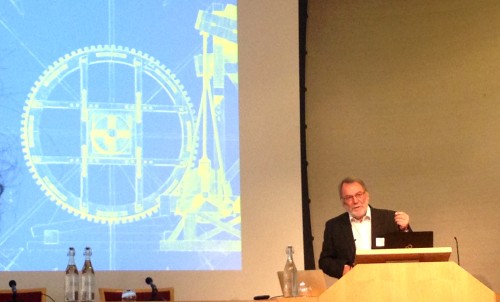Posts by: Tushna Commissariat
Symmetry-violating neutrinos may hold the key to antimatter

Deep trap: Inside the Super-Kamiokande neutrino detector. (Courtesy: T2K Collaboration)
By Tushna Commissariat
As you may have read, earlier this week I was at Neutrino 2016 – the 27th International Conference on Neutrino Physics and Astrophysics – in London. Although I was only at two days of the week-long conference, I still have neutrinos on my mind. A whole host of experiments presented various data and updates. Indeed, the researchers presenting the latest results from the Tokai to Kamioka (T2K) experiment in Japan and the NOvA Neutrino Experiment at Fermilab in the US had some interesting things to say.
T2K collaborator Hirohisa Tanaka, from the University of Toronto in Canada, revealed that the experiment’s most recent data seem to support earlier hints that there may be different oscillation probabilities for neutrinos and antineutrinos. If these data hold up, then it would have big consequences – the standard model of neutrino physics says that these two oscillation rates should be the same so as not to violate charge–parity (CP) symmetry. According to the collaboration, their observed “electron antineutrino appearance event rate is lower than would be expected based on the electron neutrino appearance event rate, assuming that CP symmetry is conserved”.
Cosmic messengers and the rise of neutrino astronomy

Cool operator: Marek Kowalski talking about IceCube at the Neutrino 2016 conference. (Courtesy: Tushna Commissariat)
By Tushna Commissariat at the Royal Geographical Society in London
“There are still many things to be studied in neutrinos,” said 2015 Nobel laureate Takaaki Kajita at the first talk of the Neutrino 2016 conference that began in London today. I couldn’t help but notice that his statement rang very true, as the day’s talks touched on everything from high-energy neutrinos to dark-matter searches to monitoring nuclear reactors. This year, more than 700 physicists from all over the world are attending the week-long conference, which is taking place at the historic Royal Geographical Society in London.
Second wave: all about LIGO, black holes, gravitational ripples and more
By Tushna Commissariat
What an exciting week it has been, as the LIGO and Virgo collaborations announced that they have definitely detected a second gravitational wave event using the Advanced Laser Interferometer Gravitational-wave Observatory (aLIGO) in the US. These waves made their way into aLIGO early on Boxing Day last year (in fact it was still very late on Christmas Day in the US states where the twin detectors are located), a mere three months after the first gravitational-wave event was detected on 14 September 2015.
This event once again involved the collision and merger of two stellar-mass black holes, and since the “Boxing Day binary” is still on my mind, this week’s Red Folder is a collection of all the lovely images, videos, infographics and learning tools that have emerged since Wednesday.
LIGO physicist and comic artist Nutsinee Kijbunchoo has drawn a cartoon showing that while the researchers were excited about the swift second wave, they were a bit spoilt by the first, which was loud and clear – and could be seen by naked eye in the data. The black holes involved in the latest wave were smaller and a bit further away, meaning the signal was fainter, but actually lasted for longer in the detectors.
View all posts by this author | View this author's profile
Fractals and infinite curves, sonified data and farewell to Sir Tom Kibble
By Tushna Commissariat
Fractals have always fascinated me and I am sure it’s the same for many of you. What I find most intriguing about them is how the relatively simple base pattern, or “seed”, quickly scales up to form the intricate designs we see in a snowflake or a coastline. In the video above, mathematician and animator Grant Sanderson has created a montage of “space filling curves” – theoretically speaking, such curves can endlessly expand without every crossing its own path to fill an infinite space. Following on from these curves, Sanderson shows you just how a simple seed pattern grows into a fractal and also describes how small changes to a seed property – such as an angle in a V – can alter the final image. The above video follows from a previous one Sanderson created on “Hilbert’s curve, and the usefulness of infinite results in a finite world” so check them both out.
View all posts by this author | View this author's profile
Rosetta and bedbugs, LIGO and dark matter, arXiving science and more…
By Tushna Commissariat
Space missions and insects are not the most usual of bedfellows. But in a wonderful example of how space technology can be translated into practical devices for use here on Earth, a UK company has repurposed and adapted an analyser used onboard the Rosetta mission – that in 2014 landed a probe on a comet for the first time – to sniff out bedbugs. The pest-control company, Insect Research Systems, has created a 3D-printed detector that picks up bodily gas emissions from bedbugs – such a device could be of particular use in the hotel industry, for example, where many rooms need to be quickly scanned. The device is based on the Ptolemy analyser on the Philae lander, which was designed to use mass spectroscopy to study the comet’s surface.
“Thanks to the latest 3D-printing capabilities, excellent design input and technical support available at the Campus Technology Hub, we have been able to optimize the design of our prototype and now have a product that we can demonstrate to future investors,” says Taff Morgan, Insect Research Systems chief technical officer, who was one of the main scientists on Ptolemy. In the TEDx video above, he talks about the many technological spin-offs that came from Ptolemy – skip ahead to 13:45 if you only want to hear about the bedbugs, though.
Spiralling temperatures, physics legacies, the science of mac and cheese

Ring of fire: spiralling global temperatures. Created by climate scientist Ed Hawkins of the University of Reading.
By Tushna Commissariat
As we face up to the realities of global warming and see the effects of climate change become apparent, it’s more important than ever that people the world over truly grasp its impact. With this in mind, University of Reading climate scientist Ed Hawkins has created the above animated spiral, which shows how the global temperature has changed over the past 166 years. Using data from the Met Office’s Hadley Centre observations datasets, Hawkins’ animation presents data in a a clear and artistic way. “The pace of change is immediately obvious, especially over the past few decades. The relationship between current global temperatures and the internationally discussed target limits are also clear without much complex interpretation needed,” says Hawkins, who is based at the university’s National Centre for Atmospheric Science. Take a look at his webpage to learn more about the project and for a list of specific weather events that are noticeable in the data.
View all posts by this author | View this author's profile
Looking toward the quantum-technology landscape of the future

Futuristic views: Peter Knight opening the conference at the Royal Society in London. (Courtesy: Tushna Commissariat)
By Tushna Commissariat
Not a week goes by here at Physics World that we don’t cover some advance in quantum mechanics – be it another step towards quantum computing or error correction, or a new type of quantum sensor, or another basic principle being verified and tested at new scales. While each advance may not always be a breakthrough, it is fair to say that the field has grown by leaps and bound in the last 20 years or so. Indeed, it has seen at least two “revolutions” since it first began and is now poised on the brink of a third, as scientific groups and companies around the world race to build the first quantum computer.
With this in mind, some of the stalwarts of the field – including Peter Knight, Ian Walmsley, Gerard Milburn, Stephen Till and Jonathan Pritchard – organized a two-day discussion meeting at the Royal Society in London, titled “Quantum technology for the 21st century“, which I decided to attend. The meeting’s main aim was to bring together academic and industry leaders “in quantum physics and engineering to identify the next generation of quantum technologies for translational development”. As Knight said during his opening speech, the time has come to “balance the massive leaps that the science has made with actual practical technology”.
View all posts by this author | View this author's profile
Climate change and chaos, the many faces of physics, spider-silk superlenses and more
By Tushna Commissariat
In case you have ever wondered why so many theoretical physicists study climate change, physicist Tim Palmer from the University of Oxford in the UK has a simple answer: “because climate change is a problem in theoretical physics”. Indeed, Palmer, who won the Institute of Physics’ 2014 Dirac medal, studies the predictability and dynamics of weather and climate, in the hopes of developing accurate predictions of long-term climate change. The answer, according to Palmer, lies at the intersection between chaos theory and inexact computing – which requires us to stop thinking of computers as deterministic calculating machines and to instead “embrace inexactness” in computing. Palmer talked about all this and more in the latest public lecture from the Perimeter Institute in Canada – you can watch his full talk above.
When someone says the word “physicist”, what image or persona comes to mind? That is the question the Institute of Physics (which publishes Physics World) was hoping to answer with its recent member survey based on diversity, titled “What Does a Physicist Look Like?” The Institute’s main aim with this diversity survey, which about 13% of its members responded to, was “to understand the profile of our members and gain some insights into who they are – diverse people with different ages, ethnicities, beliefs and much more”. You can read its entire results here.
The toll of a year in space, running a marathon on the ISS, skip-diving at CERN and more
By Tushna Commissariat and Michael Banks
“A year here is a really really long time,” says astronaut Scott Kelly in an interview (watch the video above) that he did on board the International Space Station (ISS) just a month before he returned to Earth in March this year. The retired astronaut is talking about the very real effects of spending a long period in space, specifically citing both the physical effects as well as the “psychological stress” involved. “During my time in orbit, I lost bone mass, my muscles atrophied and my blood redistributed itself in my body, which strained my heart. Every day I was exposed to 10 times the radiation of a person on Earth, which will increase my risk of developing a fatal cancer for the rest of my life. Not to mention the psychological stress, which is harder to quantify and is perhaps as damaging,” he says.
The comments were part of the announcement of his upcoming memoir, Endurance: My Year in Space and Our Journey to Mars, which will be published later this year. Despite the damming tone, Kelly is still a staunch supporter of manned spaceflight and missions such as those to Mars, he just has a much clearer view on the realities involved. Read more about his announcement over at the GeekWire website.
View all posts by this author | View this author's profile
3D-printed dog’s nose sniffs out why canines are excellent chemical analysers
By Tushna Commissariat
After a long trip in the US – attending the APS March meeting and visiting both the Maryland campus of the National Institute for Standards and Technology, as well as the Brookhaven National Laboratory in New York – I finally made my way back home yesterday. As I flew out of New York, I was reminded of my visit to NIST’s Surface and Trace Chemical Analysis Group, where researchers develop a variety of ways to detect contraband substances at airports and other public locations. While the team looks into a variety of ways to detect trace residues of banned substances such as drugs or explosives that may be found on people or objects – from mass spectroscopy to thermal desorption to vapour-sampling – my favourite was their canine research that led them to create a 3D-printed dog’s nose!